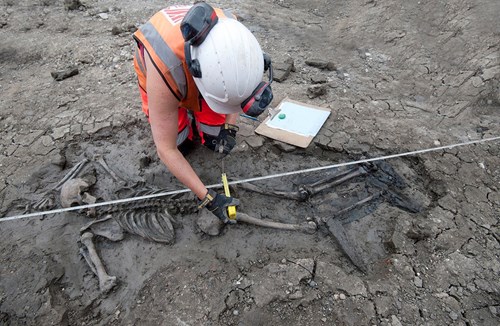Archaeologists working on London’s super sewer try to unravel the medieval mystery of the booted man in the mud
Archaeologists working on London’s super sewer have revealed some fascinating insights into the life of a man who likely worked on the River Thames hundreds of years ago, after finding his skeleton on the foreshore.
The male skeleton was found lying face-down, buried deep in mud and wearing knee-high leather boots at Tideway’s Chambers Wharf site in Bermondsey, where work is currently underway to build London’s new super sewer to stop sewage pollution in the River Thames.
Experts from the Museum of London Archaeology (MOLA) believe he could have made his living from the river as a sailor, fisherman or mudlark, as his boots - which were reinforced with extra soles - would have made ideal waders.
They believe the man, who died around 500 years ago, fell in to the river or was pushed. It is unlikely that someone would have been buried wearing the boots, as leather was expensive and often re-used, while his position - face down, with one arm above his head and the other behind his back - suggests that he was not found in a deliberate grave.
Jack Russell, Archaeology Lead for Tideway, said: “The Tideway archaeology programme has allowed us to gather really interesting new evidence for how Londoners have used the river throughout history. As we work towards our goal of cleaning up the Thames and reconnecting London with it, it’s really important to acknowledge the lessons we can learn from significant discoveries like this.”
The man is believed to have died when he was aged around 20-30 and analysis has revealed that he lived a tough life. He survived stresses in childhood, evident in defects in his teeth; blunt force trauma to the front of his skull; and a broken nose that had subsequently healed.
Experts also found deep grooves on his teeth caused by a repetitive action – possibly by passing rope between his teeth as a fisherman might.

Niamh Carty, Human Osteologist at MOLA Headland, said: “Studying a human skeleton provides incredible insights that allow us to create osteo-biographies of a person’s life. With the booted man, examining his teeth has given clues about his childhood and marks on his skeleton have allowed us to proffer ideas about the aches and pains he may have suffered from on a daily basis, the toll his job took on his body and even a little about what he might have looked like.”
Beth Richardson, Finds Specialist at MOLA Headland, said: “By studying the boots we’ve been able to gain a fascinating glimpse into the daily life of a man who lived as many as 500 years ago. They have helped us to better understand how he may have made his living in hazardous and difficult conditions, but also how he may have died. It has been a privilege to be able to study something so rare and so personal.”
The skeleton was uncovered during the construction of a shaft at Chambers Wharf, where one of the main tunnel boring machines digging the super sewer is due to start tunnelling later next year.
This is close to where the Bermondsey Wall – a huge mud bank beside the river supported by wooden structures - is known to have stood. Archaeologists have said he may have even been climbing the Bermondsey Wall when he fell or became trapped in the silty foreshore and drowned.
We may never know the answer to exactly how the booted man came to rest in the river, but his untimely death has offered an incredible opportunity to learn from him: to explore the relationships between the people of London in the past and the river Thames and how this dangerous and powerful natural resource was the used by so many as a means of making a living.
